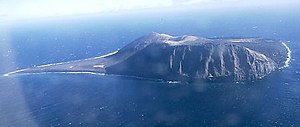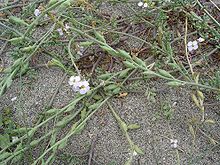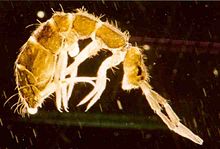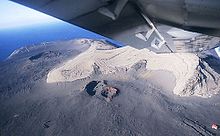Surtsey
| Surtsey | ||
|---|---|---|
| Surtsey, 1999 | ||
| Waters | Atlantic Ocean | |
| Archipelago | Vestmannaeyjar | |
| Geographical location | 63 ° 18 ′ 0 ″ N , 20 ° 36 ′ 0 ″ W | |
|
|
||
| length | 1.7 km | |
| width | 1.4 km | |
| surface | 1.4 km² | |
| Highest elevation | Austurbunki 154 m |
|
| Residents | uninhabited | |
| Topographic map | ||
Surtsey [ 'sør̥tsɛi ] ( Icelandic for island of Surt ) is a volcanic island in the Atlantic Ocean that was formed in a series of eruptions on November 14, 1963 and is located about 30 kilometers off the south coast of Iceland . It is the second largest of the Vestmannaeyjar or Westman Islands after Heimaey and represents the southernmost point of Iceland .
Surtsey was created by a submarine volcanic eruption , which later broke through the sea surface and built today's island from tephra and lavas . There are now research stations on the island, which is under strict nature protection. Surtsey may only be entered for scientific purposes.
More detailed description of the volcanic island
Surtsey, the most south-westerly of the Westman Islands, is the visible part of an undersea volcano . The volcanic building consists of an approx. 6 km long, northeast-oriented ridge with an area of around 14 square kilometers. The island itself is characterized by two tuff mountains and a Pāhoehoe lava field that covers the southern part of Surtsey.
Creation of Surtsey
Harbingers of the eruption
On November 14, 1963 at 06:55 UTC , the crew of the fishing vessel Ísleifur II sailing off the coast of Vestmannaeyjar noticed a strong smell of hydrogen sulfide in the air. At around 07:15 UTC a dark cloud of smoke was visible a few kilometers from the ship. The ship moved closer to the smoke as the Ísleifur's captain thought it might be a burning ship. However, the smoke was caused by eruptions that released black ash, suggesting volcanic activity on the ocean floor.
Although the eruptions were unexpected, there had previously been signs of a future underwater volcano eruption. A week earlier, seismographs in Reykjavík, 110 kilometers away, and in Kirkjubæjarklaustur had recorded smaller earthquakes , but their exact location was not determined. Two days before the eruption, a research vessel found that the sea in the region was slightly warmer than usual. At the same time, residents of the town of Vík í Mýrdal , 80 kilometers away on the mainland, reported having smelled hydrogen sulfide .
The bottom of the sea is 130 meters below sea level. At this depth, explosive eruptions are weakened by the water pressure. When the eruptions formed a volcanic cone nearing sea level, the explosions were no longer affected by water pressure, and the eruptions reached the surface.
The first phases
If the height of the eruption column was below 100 meters at 8 a.m. on November 14, 1963, by 10 a.m. it had increased to 3000 meters and continued to rise. The eruptions first took place at three separate eruption points along a 400-meter-long fissure pointing from northeast to southwest, which, however, merged in further phreatomagmatic eruptions into a single large eruption point in the course of the afternoon . The volcano towered above sea level on the first night after the eruption was discovered. The explosive phase of the eruption continued during the following week, and after a few days a 500 meter long and up to 45 meter high island of hyaloclastites , pillow lavas and layers of lava , slag and ash from alkali olivine basalt had formed. The explosive phase lasted four and a half months.
The ongoing eruptions were increasingly concentrated in two craters, later called Vesturbunki and Austurbunki. Sometimes it was mixed eruptions, as long as one crater was already protruding completely out of the water and the explosive activity continued in it, which, however, was of a different quality than the phreatomagmatic explosions in the other crater, which was still flooded by water. On November 24th, the island was already 900 meters by 650 meters.
Austurbunki already reached a height of 174 meters (300 meters above the sea floor) in this first phase of the eruption.
The island initially consisted largely of loose rock, which favored rapid erosion by winter storms in the North Atlantic. However, the eruptions more than made up for the loss of material due to erosion. In February 1964, the island had already reached a maximum diameter of over 1,300 meters.
A permanent island

The phreatomagmatic explosions caused by the penetration of seawater into the eruption openings hurled rocks up to a kilometer away from Surtsey and created an eruption column up to 10 kilometers high above the volcano. Without the continuous supply of magma, the erosion would have broken down the loose pyroclastics . During this time, clouds of ash were often observed blowing away from the island by the wind.
In 1964, the island had grown to such an extent that no seawater could enter the magma channels.
From April 1964, the eruption on the main island of Surtsey turned into an effusive phase and within a year built a shield volcano on the hyaloclastite base. Using this example, scientists were able to observe the formation of a tabular volcano for the first time.
The volcanic activity lost its explosiveness and mainly lava was now ejected. The subsequent transformation of hyaloclastites into hard palagonite resulted in an erosion-resistant rock shell around large parts of the island, which slowed down further erosion by sea and wind considerably. The most recently released lavas, however, were degraded relatively quickly.
The eruptions lasted until 1965, when the island reached its greatest extent with a surface of 2.5 km².
Outbreaks around Surtsey
On December 28, 1963, submarine eruptions began about 2.5 kilometers northeast of Surtsey, forming a 100 m long ridge called Surtla on the sea floor , which, however, never reached sea level. The eruptions ended on January 6, 1964, and since then the ridge has eroded from its maximum height of 23 m below sea level to 47 m below sea level.
In the summer of 1965, a volcanic eruption was discovered on the sea floor northeast of Surtsey. As this approached the surface of the sea, it went into an explosive phase and built the island of Syrtlingur . It reached a height of 70 m and a surface of 0.15 km². However, this fell a short time later until October 24, 1965, the sea erosion victim. In 2000, measurements were taken in the sea and found 33 m water depth over the former island.
On December 26, 1965, another submarine volcanic eruption began in southwest Surtsey and lasted until August 1966. The island of Jólnir was formed . It also reached a height of 70 m, but a surface of at least 0.28 km². But it was also completely eroded again by October 1966.
Final phase of the outbreak series
From August 16, 1966, another effusive volcanic eruption took place from a crevice in the eastern crater. These eruptions ended on June 5, 1967, ending the series of eruptions on and around Surtsey. At the same time, eruptions from small crevices in the eastern crater had taken place from October 1966 to January 1967.
Results
The total volume of material ejected in three and a half years was approximately 1.1 cubic kilometers. Of this, 70 percent was tephra , the remaining 30 percent lava . At the end of the eruptions, the highest point on the island was 174 meters above sea level, the maximum area was 2.65 km².
Since the end of the eruptions, the island's area has decreased due to erosion . A larger area on the southeast side has completely disappeared. In return, the sandbank Norðurtangi (northern point) formed on the north side , which enlarged the island somewhat. The last measurements of the island in 2007 only found a surface of 1.4 km².
Name and jurisdiction
The name Surtsey was given after the fire giant Surt in Norse mythology . The inhabitants of the Vestmannaeyjar would have preferred the name Vesturey (West Island) and drove to Surtsey on December 13th to hold a corresponding baptism ceremony. Shortly after the men entered the island, however, violent eruptions drove them away. It stayed with the name Surtsey.
During the first days of the island, three French journalists from Paris Match magazine landed on the island on December 6, 1963. They stayed on Surtsey for about 15 minutes before violent eruptions caused them to leave. They then jokingly claimed the sovereignty of France over the island, to which the Icelandic authorities immediately objected that Surtsey was formed in Icelandic territorial waters. Even after the creation of the volcanic island of Ferdinandea near Sicily , there had been controversies about rule over the island.
The settlement of life
Surtsey is a popular study site for the settlement of founder populations . The island was declared a nature reserve as early as 1965 - while it was still volcanically active. Nowadays only a small number of scientists are allowed to enter the island, up to now there have been around a hundred people in total. Individuals can only see Surtsey from airplanes or boats.
The starting conditions for a colonization by living beings were unfavorable, as the island is covered by storms for most of the year and rainwater could not initially be collected from the barren soil.
plants
The settlement of plants on the island has been extensively investigated since the island was formed and has progressed surprisingly quickly. The first vascular plants were seen as early as 1965 . The first colonists were sea mustard ( Cakile arctica ), followed by sea rye ( Leymus arenarius , 1966), chickweed ( Honckenya peploides , 1967) and oyster plants ( Mertensia maritima , 1967). These first settlers were first to be found on the beaches due to the way they were spread.
Mosses and lichens, on the other hand, were not detected for the first time until 1968 and 1970, respectively. They preferred to grow at outlets for hot steam from the earth, where they thrived in a humid climate. The first permanently detectable species from 1968 onwards were the real rotary moss ( Funaria hygrometrica ) and silver moss ( Bryum argenteum ), and since 1970 also the lichen of the species Trapelia coarctata .
There are currently 51 permanently settled vascular plants as well as 75 mosses and 71 lichens on the island . The island is completely covered with plants except for the steep paragonite hills inside.
Botanists found that the seeds of some plants had drifted over a distance of 20 kilometers from the southern bay of Heimaey Island. To support this finding, an experiment was carried out with 10 million plastic beads. Of the pearls scattered into the sea at Heimaey, about 1 percent actually arrived on the banks of Surtsey. Above all, the first settlers reached the island promptly in this way. Nevertheless, scientists estimate that a total of 75 percent of the vascular plant species on Surtsey were brought in by birds and only 14 percent by wind and 11 percent by the sea.
Birds

The increase in the bird population on the island takes place depending on the plants occurring on the island, conversely it then contributes to the thriving of the plants again. Birds use plants as nesting material, but in return they help by distributing the seeds and fertilizing the soil with their guano . The first birds nested on Surtsey three years after the eruptions ended, with the fulmar and guillemot being the first species. In 1970 they also gave birth to the first warm-blooded animals to hatch on the island : two black guillemots and a fulmar.
Today eight species are native to the island. The first seagulls landed on the island just a few weeks after first surfacing. A permanent seagull colony has been on Surtsey since 1986 - 300 pairs in 1999. Due to the high number of animals, it has a great influence on the plant life on the island. Nesting puffins were also discovered in 2004 and are abundant in Iceland.
In addition to providing permanent habitat for native birds, Surtsey also offers a roost for migratory birds. Birds that fly to Iceland from the British Isles in particular use Surtsey for a stopover. Whooper swans , geese and ravens have already been sighted. Although Surtsey is west of the usual migratory routes, the growth of vegetation has made it an attractive resting place. A total of 89 different species have been identified so far.
Life under water
Soon after the island was formed, seals were discovered around the island. They started sunbathing on the island early, especially in the northern part, which was less prone to erosion. The first seals with offspring were sighted on the island as early as 1983. Today around 70 animals use the island as a habitat. Gray seals are more common than common seals , but both species have become established.
The presence of seals also attracts their predator, the killer whale , which is common in the waters around Vestmannaeyjar and also around Surtsey.
Many species are native to the underwater areas around the island. Starfish are widespread, as are sea urchins and limpets . The rocks are covered with algae , seaweed covers large parts of the slopes, especially at depths between 10 and 20 m.
Other living things
Insects reached Surtsey shortly after the island was formed; they could be detected as early as 1964. The first to reach Surtsey on their own, supported by the wind, were flying insects. Some probably even made their way to Surtsey from continental Europe. Later insects reached the island via driftwood, as well as live and dead animals that washed up.
On August 1, 1974, a bundle of grass measuring 90 × 20 × 10 cm was washed ashore. About half (884 g) of it was removed by scientists and examined with the help of a Berlese funnel. A total of 653 land animals were discovered in the sample, mainly mites and springtails . In the following year, 1975, the first springtails could also be registered on the island itself.
In 2002 a series of tests showed that springtails are also able to spend significant periods of time in salt water without being harmed. The settlement of insects provided food for the birds. In return, dead birds, for example, provided a source of food for carnivorous insects. Herbivorous insects were also able to settle on the island after the flora had spread . Land animals that have developed completely differently have also reached the island. Earthworms were discovered in a soil sample in 1993, presumably they were flown in by birds from Heimaey. Snails were discovered in 1998 and are the same species as in the south of the main Icelandic island. Even spiders and beetles have been spotted on Surtsey.
In total, over 300 different species were registered by 2002. Most of them are airworthy insects, around 133 species of flies. In addition, 62 species of mites, 19 species of butterflies, ten spider, five beetle and two worm species have been identified.
The future of Surtsey
After the eruptions ended, scientists began a series of tests to identify the changes on the island. Twenty years after the island was formed, these experiments showed that the island had continuously shrunk vertically and had already lost several meters in height. At the beginning the loss of height was 20 cm per year, but in the 1990s it was only 1 to 2 centimeters per year. There were several reasons for the shrinkage: On the one hand, the loose base material of the island compacted, and on the other, the sediments under the island compacted. Under the heavy weight of the volcano, the asthenosphere also gave way and the lithosphere sank a little deeper , according to the principle of isostasis . From a maximum height of 173 meters, Surtsey has shrunk to 154 meters (2006).
The typical behavior of most volcanoes in the Vestmannaeyjar archipelago (except on Heimaey) is a single phase of volcanic activity. This makes further eruptions on Surtsey relatively unlikely long after the initial active phase.
The rough seas around the island have been eroding Surtsey since she emerged. Since the end of the eruptions, the island has lost about half of its area of 2.8 km² and was only 1.4 km² in 2006. The island is shrinking by around 1 hectare every year. However, it is unlikely that the island will disappear completely in the near future. The area, which has been eroded to this day, consisted largely of loose pyroclastics that could easily be carried away by wind and waves. Most of the rest of the island has been covered by lava and is accordingly more resistant to erosion. Chemical processes have also led to the rock inside the island slowly turning into tuff or palagonite ( isl . : moberg ) (palagonitization) . Due to the high temperature inside, this process takes place very quickly.
It has been estimated that the island will have lost all of its loose surface material by around the year 2120. Only the hard core of palagonite with an area of about 0.4 km² will be able to withstand erosion for longer. Surtsey will then resemble the other small islands in the archipelago, such as Bjarnarey or Elliðaey . These were formed in a similar way about 6000 years ago.
UNESCO world heritage
In 2001 the Icelandic government applied for the island to be included in the UNESCO World Heritage List ; this took place in July 2008.
The protected area is 65.5 km². In a 33.7 km² core zone, which includes the island itself and the submarine areas of the volcano, fishing with trawls is to be banned, but permitted in the rest of the area with restrictions.
The World Heritage Committee praised the island as an outstanding example of ongoing biological and ecological processes in the evolution of ecosystems, because there the colonization of new land by animals and plants can be observed.
See also
literature
- Sturla Friðriksson: Surtsey: evolution of life on a volcanic island . London 1975, ISBN 0-408-70700-3 .
- GH Schwabe: Surtsey, Iceland: natural first settlement (ecogenesis) of the volcanic island . Kiel 1970.
- Carl H. Lindroth: Surtsey, Iceland . 1973.
- Ulrich Münzer: Iceland: Volcanoes - Glaciers - Geysers . Münzer, Brannenburg 1996, ISBN 3-9802868-1-9 .
- Sigurdur Þorarinsson: Surtsey: birth of a volcanic island in the northern sea . Zurich 1968.
- Kathryn Lasky: Surtsey: The Newest Place on Earth . New York 1992, ISBN 1-56282-300-0 .
- Guðjón Ármann Eyjólfsson: Vestmannaeyjar. Ferðafélag Íslands, árbók 2009.
Web links
- Surtsey in the Global Volcanism Program of the Smithsonian Institution (English)
- Entry on the UNESCO World Heritage Center website ( English and French ).
- Nomination for UNESCO World Heritage (English, PDF, 10.51 MB)
- Comprehensive Island website (English)
- Volcanic activity on Surtsey (English)
- Combined aerial and satellite images (English)
- Vic Camp: Hydrovolcanic eruptions, How volcanoes work , Dept. of Geological Sciences, San Diego State University (English)
Individual evidence
- ↑ Thor Thordarson, Armann Hoskuldsson: Iceland - Classic Geology in Europe 3. Harpenden 2002, p. 95
- ↑ cf. z. B. Guðjón Ármann Eyjólfsson: Vestmannaeyjar. Ferðafélag Íslands, árbók 2009, p. 256 f.
- ↑ S.Thorarinnsson: The Surtsey eruption and related articles In: Polar Record, 13, 1967 ; Abstract , last accessed on February 5, 2011
- ^ Surtsey - Geology. Retrieved February 5, 2011 .
- ^ Guðjón Ármann Eyjólfsson: Vestmannaeyjar. Ferðafélag Íslands, árbók 2009, p. 260
- ↑ They also have the names Surtur II and Surtur I, cf. Thor Thordarson, Armann Hoskuldsson: Iceland - Classic Geology in Europe 3. Harpenden 2002, p. 95
- ↑ cf. Þorleifur Einarsson: Geology of Iceland. Rocks and landscape. Reykjavík 1991, p. 45
- ↑ a b c Ingvar Sigurðsson, Sveinn Jakobsson: Jarðsaga Vestmannaeyja. In: Guðjón Ármann Eyjólfsson: Vestmannaeyjar. Ferðafélag Íslands, árbók 2009, p. 17
- ^ Ingvar Sigurðsson, Sveinn Jakobsson: Jarðsaga Vestmannaeyja. In: Guðjón Ármann Eyjólfsson: Vestmannaeyjar. Ferðafélag Íslands, árbók 2009, p. 19 f.
- ^ Guðjón Ármann Eyjólfsson: Vestmannaeyjar. Ferðafélag Íslands, árbók 2009, p. 261
- ^ Ingvar Sigurðsson, Sveinn Jakobsson: Jarðsaga Vestmannaeyja. In: Guðjón Ármann Eyjólfsson: Vestmannaeyjar. Ferðafélag Íslands, árbók 2009, p. 20
- ^ Guðjón Ármann Eyjólfsson: Vestmannaeyjar. Ferðafélag Íslands, árbók 2009, p. 256
- ^ Guðjón Ármann Eyjólfsson: Vestmannaeyjar. Ferðafélag Íslands, árbók 2009, p. 260 f.
- ↑ Icelandic World Heritage Committee: Nomination of SURTSEY for the UNESCO World Heritage List , January 2007, www.surtsey.is/SRS_publ/WHL/Surtsey_Nomination_Report_2007_72dpi.pdf, p. 59
- ↑ Icelandic World Heritage Committee: Nomination of SURTSEY for the UNESCO World Heritage List , January 2007, www.surtsey.is/SRS_publ/WHL/Surtsey_Nomination_Report_2007_72dpi.pdf, p. 27
- ↑ Icelandic World Heritage Committee: Nomination of SURTSEY for the UNESCO World Heritage List , January 2007, www.surtsey.is/SRS_publ/WHL/Surtsey_Nomination_Report_2007_72dpi.pdf, p. 27ff
- ↑ Icelandic World Heritage Committee: Nomination of SURTSEY for the UNESCO World Heritage List , January 2007, www.surtsey.is/SRS_publ/WHL/Surtsey_Nomination_Report_2007_72dpi.pdf, p. 32
- ↑ cf. Guðjón Ármann Eyjólfsson: Vestmannaeyjar. Ferðafélag Íslands, árbók 2009, p. 266
- ^ Guðjón Ármann Eyjólfsson: Vestmannaeyjar. Ferðafélag Íslands, árbók 2009, p. 17
- ^ Guðjón Ármann Eyjólfsson: Vestmannaeyjar. Ferðafélag Íslands, árbók 2009, p. 268
- ↑ Erling Olafsson: The development of the land-arthropod fauna on Surtsey, Iceland, during 1971–1976 with notes on terrestrial Oligochaeta (PDF file; 383 kB); Reykjavík, 1978
- ^ Ingvar Sigurðsson, Sveinn Jakobsson: Jarðsaga Vestmannaeyja. In: Guðjón Ármann Eyjólfsson: Vestmannaeyjar. Ferðafélag Íslands, árbók 2009, p. 20
- ↑ SURTSEY ICELAND ( Memento from January 25, 2011 in the Internet Archive ) Accessed: February 5, 2011








